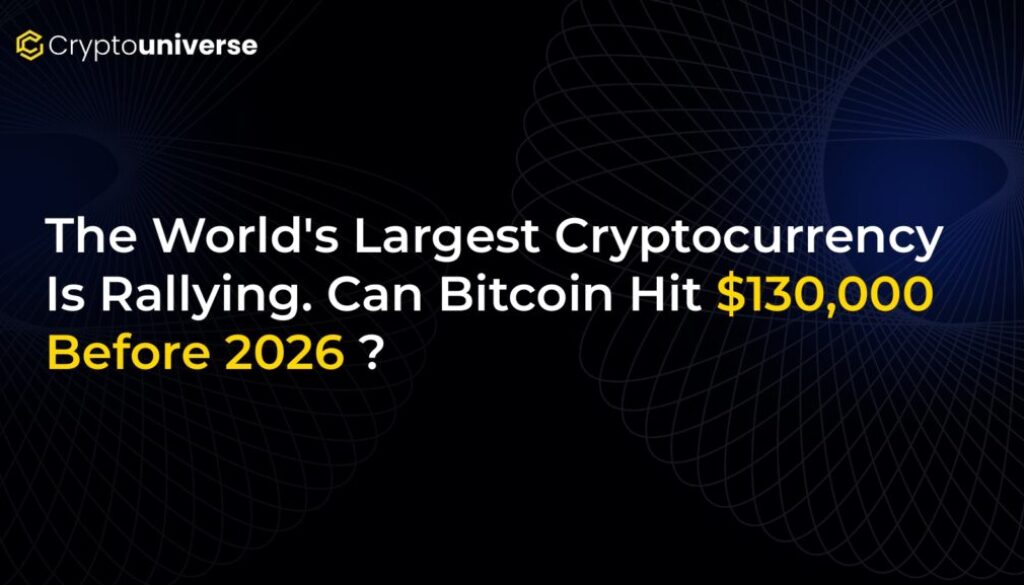The World’s Largest Cryptocurrency Is Rallying. Can Bitcoin Hit $130,000 Before 2026?

Bitcoin’s Momentum Builds: Is a Six-Figure Price Tag on the Horizon?
Bitcoin, the undisputed king of cryptocurrencies, has been on an electrifying run, smashing previous records and capturing the attention of investors worldwide. After a stellar performance that saw it breach the $73,000 mark, the conversation has shifted from recovery to explosive new heights. The question on everyone’s mind is no longer if Bitcoin will see another bull run, but how high it can go. Specifically,
While past performance is no guarantee of future results, a powerful combination of tightening supply, unprecedented demand, and a shaky global economic outlook is creating a perfect storm for the digital asset. Let’s break down the key drivers that could propel Bitcoin into the six-figure territory sooner than many think.
A Tale of Two Forces: Squeezed Supply Meets Insatiable Demand
The current Bitcoin rally isn’t built on hype alone. It’s underpinned by fundamental economic principles of supply and demand that are stronger than ever before.
The Halving Effect: Less New Bitcoin, More Potential Value
In April 2024, the Bitcoin network underwent its fourth “halving.” This is a pre-programmed event that occurs roughly every four years, cutting the reward for mining new blocks in half. In simple terms, the rate at which new Bitcoin is created has been slashed from about 900 BTC per day to just 450.
With a fixed maximum supply of 21 million coins, this programmed scarcity is a core feature of Bitcoin’s value proposition. As the flow of new coins dwindles, the existing supply becomes more valuable, especially when demand is rising. Historically, the periods following a halving have been characterized by significant price appreciation, and the current cycle appears to be following this powerful trend.
The ETF Revolution: Wall Street Is Buying Bitcoin by the Truckload
While the supply is tightening, demand has exploded from a new and powerful source: Wall Street. The approval and launch of spot Bitcoin ETFs in the United States have been a game-changer, providing a regulated, accessible, and straightforward way for institutional and retail investors to gain exposure to Bitcoin.
The results have been staggering. Billions of dollars have poured into these new financial products, with global crypto ETFs seeing record inflows. This sustained buying pressure from major financial institutions represents a massive wave of new capital entering the market. Unlike previous bull runs driven primarily by retail enthusiasm, this cycle is backed by deep-pocketed institutional players who are now competing for a shrinking daily supply of new coins.
The Macro Catalyst: Why Bitcoin Is Becoming ‘Digital Gold’
Beyond its internal dynamics, Bitcoin’s appeal is being amplified by the global economic environment. Investors are increasingly looking for safe havens to protect their wealth, and Bitcoin is fitting the bill.
The Dollar Debasement Narrative
Many are growing concerned about the long-term stability of fiat currencies like the U.S. dollar. Persistent inflation erodes purchasing power, while rising government debt raises questions about future fiscal sustainability. In this environment, assets with a credibly scarce and unchangeable supply become incredibly attractive.
Gold has traditionally played this role, but Bitcoin offers a modern, digital alternative. Its fixed cap, decentralized nature, and global portability make it a compelling hedge against currency debasement and economic uncertainty. As more investors embrace this “digital gold” narrative, capital is likely to continue flowing from traditional markets into Bitcoin.
The Path to $130,000: Plausible or Pipe Dream?
When you combine these powerful forces, the target of $130,000 seems less like a distant dream and more like a logical next step. A move from its recent all-time high to $130,000 would represent a significant rally, but it’s well within the realm of possibility given the asset’s historical volatility during bull cycles.
- Supply Shock: The halving has created a predictable supply squeeze.
- Demand Shock: ETFs have unlocked a torrent of institutional demand.
- Macro Tailwinds: Economic uncertainty is pushing investors toward scarce assets.
Of course, no investment is without risk. A sudden downturn in the global economy or harsh regulatory action could stall the momentum. However, the fundamental structure of the current market is undeniably skewed to the upside.
How to Approach Bitcoin in the Current Market
For those looking to invest, trying to time the market perfectly is a fool’s errand. Instead, a more prudent strategy is to adopt a long-term perspective.
Consider dollar-cost averaging (DCA), which involves investing a fixed amount of money at regular intervals, regardless of the price. This approach helps smooth out the impact of volatility and avoids the emotional trap of buying high out of FOMO or selling low out of fear.
The investment thesis for Bitcoin is a multi-year story. By focusing on the long-term drivers—scarcity, adoption, and its role as a store of value—investors can better navigate the short-term noise. If the current trends of institutional adoption and dollar debasement continue, Bitcoin won’t just hit $130,000; it could blow right past it.


